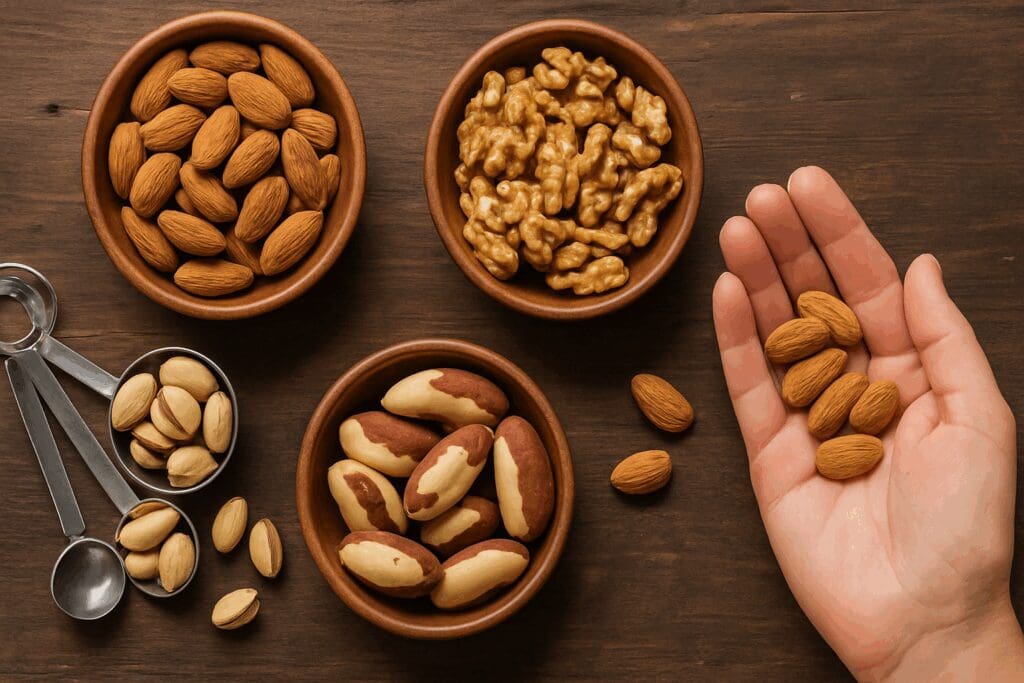The question of “is it okay to eat” certain common foods every day has moved beyond casual curiosity into a subject of intense interest for both consumers and nutritionists alike. In a world where dietary guidance can change overnight, many individuals are left wondering whether their daily food routines are helping or harming their health. From bananas and eggs to bread and yogurt, the foods we regularly consume hold a complex mix of benefits and potential drawbacks. At the heart of this exploration lies the science of dietary frequency—how often we eat specific foods and how that rhythm aligns with our nutritional needs, metabolism, and long-term health outcomes.
You may also like: 10 Essential Nutrition Rules to Follow for a Healthy Diet for Women in 20s
Rethinking Daily Food Choices Through a Scientific Lens
Modern dietary habits are often shaped by convenience, culture, and familiarity, rather than critical evaluation. Many people eat the same breakfast, lunch, or snack every day without giving much thought to nutritional variety. However, when we delve deeper into what constitutes a healthy, balanced diet, questions around food repetition naturally arise. The human body thrives on diversity—nutrient diversity, microbial diversity in the gut, and metabolic variation throughout the day. That said, consistency isn’t inherently bad. The key lies in choosing the right foods and balancing them intelligently within one’s daily and weekly eating schedule.
Nutritional science emphasizes the importance of understanding not just what we eat, but how often we eat it. For instance, when considering how frequently should you eat a particular food, the conversation must address both macro- and micronutrient load, as well as potential toxins or inflammatory properties that may accumulate with habitual intake. Furthermore, cultural norms around how many meals should you eat a day or how many times should you eat a day add another layer of complexity to personal dietary decisions. We are increasingly realizing that one-size-fits-all nutrition models are inadequate and often misleading.

Is It Okay to Eat Eggs Every Day? Debunking the Cholesterol Myth
Eggs have long been the center of controversy, largely due to their cholesterol content. One large egg contains approximately 186 milligrams of cholesterol, which is concentrated in the yolk. For decades, dietary guidelines suggested limiting egg consumption, especially for individuals at risk of cardiovascular disease. However, more recent studies have overturned these fears, indicating that for most healthy individuals, moderate daily egg consumption does not significantly affect blood cholesterol levels or increase heart disease risk.
The human body regulates cholesterol production based on dietary intake. When cholesterol intake from food rises, endogenous production typically decreases to maintain homeostasis. Moreover, eggs are a powerhouse of nutrition—offering high-quality protein, essential fatty acids, choline (which supports brain function), lutein, and zeaxanthin (which benefit eye health). Thus, for many people, eating one egg a day is not only safe but potentially beneficial.
Still, moderation and context are essential. For someone who consumes large amounts of saturated fat, red meat, and processed foods, adding daily eggs might push cholesterol levels into a problematic range. But in a balanced diet rich in fruits, vegetables, and whole grains, eggs can be part of a healthy pattern. Portion size matters, too. Knowing how much food you eat at one time helps determine whether a nutrient-dense food like eggs contributes positively or excessively to your daily intake.

Yogurt and the Gut: Is It Okay to Eat Yogurt Daily?
The rising interest in probiotics has led many to include yogurt in their daily routines, often with the assumption that more is always better. Yogurt—particularly the plain, unsweetened, and probiotic-rich variety—is undoubtedly a health-supportive food. It provides calcium, protein, and beneficial live cultures that may enhance digestive and immune health. For individuals seeking to improve gut microbiota diversity, eating yogurt every day can be a smart move.
Still, not all yogurt is created equal. Many commercial brands are heavily sweetened or contain artificial thickeners, colors, and flavors. Regularly consuming these versions may inadvertently lead to increased sugar intake, potentially affecting metabolic health and weight regulation. Thus, the type of yogurt chosen—and how frequently it’s consumed—makes a significant difference.
Experts recommend paying attention to both serving size and overall dietary composition. The question is not just “is it okay to eat yogurt every day?” but “what kind of yogurt are you eating, and how does it fit into the rest of your nutrition?” A daily serving of high-protein, low-sugar Greek yogurt can support weight management and muscle maintenance, while offering a consistent source of probiotics. As with all foods, diversity still plays a role—incorporating other fermented foods like kefir, kimchi, and miso can provide complementary microbial strains and nutritional benefits.

Is It Okay to Eat Bread Daily in a Carbohydrate-Conscious World?
Bread has become another staple food under scrutiny, especially as low-carb and gluten-free diets gain traction. While some people avoid bread entirely due to concerns about weight gain or inflammation, it’s important to distinguish between types of bread and how they interact with individual health profiles. Whole grain bread, for instance, offers fiber, B vitamins, magnesium, and sustained energy. In contrast, white bread made from refined flour provides quick-digesting carbohydrates with fewer nutrients.
Eating bread daily isn’t inherently bad. However, how much food you eat at one time and what kind of bread you’re consuming matters greatly. Consuming large portions of refined bread multiple times a day can contribute to blood sugar spikes and insulin resistance over time, especially when not balanced with fiber, protein, or healthy fats.
Whole grain or sprouted breads can be a better alternative for regular consumption. These varieties release glucose more slowly and help maintain satiety. Understanding how often should you eat bread should also be guided by activity level, metabolic health, and cultural dietary patterns. In Mediterranean cultures, bread is often consumed daily—but in modest portions and typically alongside vegetables, legumes, and olive oil. Thus, context again dictates whether a daily habit is beneficial or problematic.
The Truth About Daily Fruit Intake: Is It Too Much Sugar?
Fruits have long been celebrated as nature’s candy, rich in antioxidants, fiber, and essential vitamins. Yet in the era of sugar consciousness, even natural sugars are being questioned. The concern isn’t entirely unfounded—fructose, the primary sugar in fruit, can contribute to metabolic issues if consumed in excess, especially in the form of juice or dried fruits, which are more concentrated and less filling.
Still, most people benefit from eating a variety of fresh fruits every day. The fiber content helps slow sugar absorption, while the water content contributes to hydration and satiety. Moreover, different fruits provide different phytonutrients—anthocyanins in berries, beta-carotene in mangoes, or potassium in bananas—making variety essential. For this reason, asking how frequently should you eat fruit is not as simple as setting a numeric cap. The answer lies in diversity, moderation, and form.
It is also essential to consider portion size. How much is a serving of fruit? According to dietary guidelines, one medium piece of fruit, half a cup of chopped fruit, or a quarter cup of dried fruit constitutes a serving. Most adults can safely consume 2–4 servings of fruit daily, depending on caloric needs and activity levels. In contrast, consuming several fruit smoothies per day or snacking endlessly on dried fruit can inadvertently lead to excessive sugar intake—even if it’s “natural.”

Is It Okay to Eat Nuts Every Day? The Line Between Healthy and Heavy
Nuts are often labeled as superfoods—and for good reason. They are dense in nutrients, rich in healthy fats, protein, fiber, vitamin E, and minerals such as magnesium and selenium. Numerous studies associate nut consumption with a lower risk of cardiovascular disease, improved cholesterol profiles, and even cognitive benefits. But while they’re undeniably healthful, the question “is it okay to eat” nuts every day deserves closer examination, especially in the context of portion control and caloric density.
One of the primary concerns with daily nut consumption revolves around how much food you eat at one time. Because nuts are calorie-dense, it’s easy to consume 400–500 calories in a single handful without realizing it. This becomes particularly problematic when nuts are roasted in oil or salted heavily, increasing sodium and fat content. Understanding how much is a serving—a small handful, or about 1 ounce—can help individuals enjoy nuts daily without exceeding energy needs or throwing off nutrient balance.
For those managing their weight or trying to reduce overall fat intake, moderation is essential. However, daily consumption of raw or dry-roasted nuts, in proper portion sizes, can support metabolic health, aid in weight regulation, and improve satiety. Almonds, walnuts, pistachios, and Brazil nuts each bring unique nutritional benefits, from heart-healthy omega-3s to mood-stabilizing minerals. Rotating among types can help avoid overexposure to certain compounds, such as selenium in Brazil nuts, which can be harmful in excess. Like most foods, nuts demonstrate that frequency, type, and quantity matter deeply in dietary decision-making.
Bananas Every Day: Potassium Boost or Blood Sugar Spike?
Bananas are among the most commonly consumed fruits worldwide, admired for their convenience, taste, and potassium content. They are frequently recommended as a go-to snack for athletes, individuals with high blood pressure, or those seeking to ease digestion. Yet some health-conscious consumers ask: is it okay to eat a banana every day?
Nutritionally, bananas are rich in vitamin B6, vitamin C, and fiber, and offer a quick source of energy. The high potassium content—about 400–450 mg per banana—supports healthy blood pressure, muscle function, and electrolyte balance. But bananas are also relatively high in carbohydrates and natural sugars compared to some other fruits. This has led to concern among people managing diabetes or insulin resistance.
However, glycemic load—the actual blood sugar impact—depends on ripeness, serving size, and whether the banana is eaten alone or with other foods. Pairing a banana with protein or fat, such as almond butter or yogurt, can temper its glycemic impact. When considering how often should you eat bananas, it helps to remember that variety in fruit intake is beneficial. Eating a banana daily is not inherently bad, but rotating with lower-sugar fruits like berries or citrus may offer broader nutrient diversity and glycemic balance.
Also, awareness of portion size again becomes vital. A small banana is considered one serving, while large ones can be closer to two. Keeping track of how much is a serving enables consumers to make informed decisions about daily intake without sacrificing taste or nutrition.

Is It Okay to Eat Rice Every Day? Navigating White vs. Brown
In many cultures, rice is not just a staple—it is a culinary foundation. From sushi to stir-fry, rice finds its way into meals around the globe. But the increasing awareness around refined carbohydrates and blood sugar control raises the question: is it okay to eat rice every day?
The answer depends heavily on the type of rice consumed. White rice, while easy to digest and quick to prepare, is stripped of fiber and nutrients during processing. Its high glycemic index can cause rapid blood sugar spikes, particularly when consumed in large quantities or without accompanying fiber or protein. Brown rice, on the other hand, retains its bran and germ layers, offering more fiber, vitamins, and minerals. It is digested more slowly and can be a more favorable option for regular consumption.
Still, brown rice is not without its critics. Some experts point to its naturally occurring arsenic content—a mineral absorbed from soil and water—as a reason for moderation. Long-term daily consumption, especially among young children or pregnant women, may increase exposure risks. Rinsing rice thoroughly and varying grains (quinoa, barley, bulgur) can help mitigate this issue. As with all foods, considering how much food you eat at one time and how frequently you eat it plays a vital role in assessing its overall impact.
In essence, rice can be a healthful part of a balanced diet when eaten in appropriate amounts and varieties. Integrating it with legumes, vegetables, and lean proteins mirrors traditional diets shown to support longevity and metabolic health.
Cheese Daily: Nutrient Goldmine or Saturated Fat Trap?
Cheese elicits strong feelings from both lovers and skeptics. Rich, creamy, and packed with flavor, cheese also provides calcium, phosphorus, protein, and vitamin B12. But its high saturated fat and sodium content has drawn criticism, especially in conversations around heart health. This leads many to wonder: is it okay to eat cheese every day?
For most people without lactose intolerance or dairy sensitivities, moderate cheese consumption can be part of a health-supportive diet. Studies have shown that full-fat dairy, including cheese, does not necessarily correlate with increased cardiovascular disease risk when consumed in reasonable quantities. Some fermented cheeses may even provide beneficial probiotics that support gut health and immunity.
Still, context is everything. The concern often lies in how much food you eat at one time and the overall quality of the diet. Regularly adding large portions of cheese to already calorie-dense meals can lead to weight gain or increased cholesterol levels over time. Portion control is essential—a serving of cheese is typically 1 ounce, or about the size of a pair of dice. Understanding how much is a serving allows cheese lovers to enjoy daily indulgence without overstepping nutritional bounds.
Additionally, rotating types of cheese—goat, feta, ricotta, Parmesan—can bring diverse textures, flavors, and nutrient profiles. For those aiming to limit saturated fat, part-skim versions or smaller quantities of strong-flavored cheeses can deliver satisfaction with fewer health trade-offs.
How Often Should You Eat Red Meat Without Raising Health Risks?
Red meat remains a highly debated food in nutrition science. Rich in iron, zinc, B vitamins, and complete protein, it has undeniable nutritional benefits. Yet concerns about saturated fat, heme iron, and potential links to colorectal cancer and cardiovascular disease persist. Understanding how often should you eat red meat—and what forms to choose—can help navigate this complex terrain.
The key issue is not necessarily that red meat is harmful in itself, but that it is often consumed in excessive quantities and in processed forms such as bacon, sausages, and deli meats. These forms have been more strongly associated with health risks than lean, unprocessed cuts like sirloin or tenderloin. For those who enjoy red meat, limiting intake to 1–2 times per week and focusing on portion control (3–4 ounces per serving) can strike a balance between nutritional adequacy and risk reduction.
Moreover, preparation methods matter. Grilling at high temperatures or charring meat can produce compounds linked to cancer risk. Baking, slow-cooking, or using marinades with antioxidant-rich herbs and spices may help mitigate these effects. Balancing red meat consumption with plenty of plant-based proteins, fiber, and healthy fats supports a more heart-protective and anti-inflammatory dietary pattern.
Is It Okay to Eat Fish Every Day? Navigating Omega-3s and Mercury
Fish is often championed as one of the healthiest animal proteins available, particularly fatty varieties like salmon, sardines, and mackerel, which are rich in omega-3 fatty acids. These essential fats play a critical role in reducing inflammation, supporting brain health, and lowering cardiovascular risk. However, the rising awareness of mercury contamination in fish has prompted the question: is it okay to eat fish every day?
The answer, once again, lies in balance and variety. Many health authorities, including the American Heart Association, recommend eating fish at least twice a week, with an emphasis on fatty, cold-water species. But for those seeking the nutritional benefits of omega-3s daily, low-mercury fish like salmon, trout, and sardines can be safely enjoyed more frequently. It is the high-mercury species—shark, swordfish, king mackerel, and tilefish—that warrant caution, especially for pregnant women and young children.
Understanding how frequently should you eat different types of fish helps reduce exposure risk while maximizing benefits. Canned light tuna, for instance, tends to be lower in mercury than albacore. Alternating between fish and plant-based omega-3 sources—like flaxseeds, chia seeds, and walnuts—can diversify intake and support long-term health. Furthermore, monitoring portion size (about 3.5–5 ounces cooked) ensures you’re not overdoing it, even with the healthiest options.
Daily fish consumption may benefit those managing heart disease, depression, or inflammatory conditions, but as with all foods, context, quality, and variety determine the safety and efficacy of habitual intake.

Chocolate Cravings: Is It Okay to Eat Chocolate Every Day?
Few foods evoke as much joy—and guilt—as chocolate. Loved for its taste and texture, chocolate also contains beneficial polyphenols, especially in dark varieties. These antioxidants have been linked to improved blood pressure, cognitive function, and reduced inflammation. But does this mean it’s okay to eat chocolate every day?
The short answer is yes—within reason and with attention to quality and portion size. Dark chocolate with at least 70% cocoa provides higher levels of flavonoids and less sugar than milk or white chocolate. A small square (around 1 ounce) can deliver benefits without contributing to excessive calorie or sugar intake. However, commercial chocolate bars are often laden with added sugars, dairy fats, and emulsifiers that dilute their nutritional value.
Knowing how much is a serving helps manage intake. A piece of high-quality dark chocolate after a meal may satisfy sweet cravings while offering antioxidants. But consuming large portions daily—or opting for sugar-laden chocolate confections—can counteract any potential health benefits. This exemplifies how the question of “is it okay to eat” something every day must be contextualized within quantity, quality, and the rest of one’s diet.
Interestingly, some evidence suggests moderate daily chocolate consumption may positively affect mood and stress levels, likely due to its interaction with serotonin and dopamine pathways. Still, emotional reliance on chocolate for comfort can hint at imbalanced eating patterns. As always, intentionality and moderation should guide consumption.
Cereal and Breakfast Foods: A Daily Habit Worth Keeping?
Breakfast cereals range widely in nutritional value—from sugar-laden, cartoon-covered boxes to high-fiber, whole grain options. For many, cereal is a daily ritual, often accompanied by milk or plant-based alternatives. But is it okay to eat cereal every day?
The answer lies in deciphering cereal quality. Many popular brands are high in refined grains and added sugars, with little fiber or protein. These can lead to blood sugar spikes, energy crashes, and poor satiety. In contrast, cereals made with whole grains like oats, bran, or quinoa, and low in added sugars, can offer a steady energy source and support digestive health.
Adding protein-rich foods (like Greek yogurt or nuts) and healthy fats can enhance satiety and balance macronutrient intake. Understanding how frequently should you eat such breakfast staples requires looking beyond branding and marketing to actual nutrition labels and ingredients. Just as important is being mindful of portion size—how much food you eat at one time directly affects satiety and nutrient load. A standard cereal serving is usually around ¾ to 1 cup, yet many people consume double or triple that without realizing.
Rotating your breakfast routine with eggs, smoothies, or whole-grain toast can add nutritional diversity and prevent reliance on any one food source. However, if the cereal is high-quality and consumed in appropriate portions, there’s little harm in enjoying it daily—especially when paired with balanced additions.
Is It Okay to Eat the Same Meals Every Day?
In a world filled with culinary diversity and evolving food trends, it might seem counterintuitive—or even unhealthy—to eat the same meals every day. But many people, whether for convenience, routine, or health goals, repeat meals with little variation. So, is it okay to eat the same foods every day?
Nutritionally, eating the same balanced meal—rich in vegetables, healthy fats, lean proteins, and whole grains—can be perfectly acceptable. In fact, dietary monotony may benefit those managing weight, blood sugar, or digestion, as it simplifies meal planning and reduces decision fatigue. It also helps in identifying food sensitivities or allergies, as consistency can highlight any correlations between food and symptoms.
However, the primary drawback of meal repetition is nutrient narrowness. No single meal can cover all micronutrient needs over time. Over-relying on a limited set of foods can lead to deficiencies in certain vitamins, minerals, or phytonutrients. This is where the question of how often should you eat certain meals intersects with the broader principle of dietary variety. Even if the macro balance is sound, micronutrient diversity often requires rotation.
From a behavioral standpoint, variety can support greater satisfaction and prevent boredom, potentially reducing cravings and emotional eating. In short, repeating meals can be fine in the short term or in specific contexts, but over the long run, introducing variety—even within a fixed template—supports optimal health.

Understanding Portion Size and Its Influence on Daily Food Habits
The conversation around daily food habits often overlooks one critical factor: portion size. Whether you’re eating eggs, bread, or fruit daily, how much food you eat at one time plays a major role in determining whether that habit is healthy or harmful. Misjudging portion sizes is one of the most common reasons why well-intentioned diets derail.
For instance, consuming avocado daily can support heart health thanks to its monounsaturated fats and fiber. But eating an entire large avocado each day adds up to over 300 calories and 30 grams of fat. Similarly, pouring cereal “freely” can result in triple the recommended serving. Learning how much is a serving—and sticking to it—can make daily habits sustainable.
Visual aids and hand-based measuring systems (like using the palm, fist, or thumb as a guide) can be more effective than abstract measurements for most people. Moreover, recognizing hunger and fullness cues, rather than strictly adhering to external portion guidelines, fosters a healthier relationship with food.
This highlights a broader truth: the health impact of daily food choices is shaped not just by frequency or type, but also by volume. You can eat fruit every day and still maintain balanced blood sugar if servings are moderate and part of an overall nutrient-rich diet. The problem rarely lies in the food itself, but in the unseen excess.

The Role of Meal Frequency: How Many Times Should You Eat a Day?
As the nutrition world moves beyond calorie counting and into the science of metabolic flexibility and hormonal health, the age-old question resurfaces: how many times should you eat a day? Traditional advice centered on three meals—breakfast, lunch, and dinner—with optional snacks. In contrast, modern dietary trends have introduced intermittent fasting, OMAD (one meal a day), and frequent grazing models. But which approach aligns best with health, especially in the context of daily food choices?
There is no single answer that fits everyone. The ideal eating frequency depends on individual factors such as activity level, age, metabolic health, and lifestyle. Some thrive on smaller, frequent meals that stabilize blood sugar and prevent overeating. Others find that fewer, more substantial meals improve focus and digestion. Scientific evidence suggests that total daily nutrient intake and food quality matter more than how many meals should you eat a day.
That said, consistency is important. Irregular eating patterns can disrupt hunger hormones, impair glucose regulation, and lead to chaotic dietary habits. Whether you eat two, three, or six times per day, ensuring that your meals are nutritionally complete and portion-controlled remains key. This brings us back to foundational concepts like how much is a serving and how often should you eat specific food groups.
A practical approach may be to personalize meal frequency based on hunger cues and energy needs, while maintaining a structured eating window. Such flexibility can coexist with the idea of eating certain healthy foods daily—so long as intake is balanced, diversified, and attuned to your body’s needs.
How Much Food You Eat at One Time: The Hidden Driver of Diet Success
Among the most overlooked yet consequential aspects of daily eating habits is meal volume—how much food you eat at one time. Regardless of whether your diet is plant-based, high-protein, or Mediterranean, portion control determines caloric balance, nutrient density, and satiety. Large portions—even of healthy foods—can unintentionally lead to overeating, weight gain, or nutrient imbalances.
Take quinoa, for instance. It’s a nutrient-dense grain, high in fiber and complete protein. But consuming two cups cooked at every meal significantly exceeds typical caloric needs. Similarly, while avocados and nuts offer heart-healthy fats, their energy density demands careful portioning. This is where learning what a standard serving looks like becomes invaluable.
Visual cues and mindful eating practices help reinforce appropriate portion sizes. For example, a deck of cards represents a portion of meat, while a cupped hand holds a serving of rice or pasta. Educating oneself on these everyday metrics empowers better food decisions and makes the question of “is it okay to eat” something daily more answerable in context.
Portion awareness also enhances the effectiveness of other dietary strategies. Whether practicing intermittent fasting or snacking throughout the day, portion size anchors energy balance and supports weight management. In the end, how much you eat in a sitting often matters as much as what or when you eat.
Frequently Asked Questions About Smart Eating Habits and Daily Nutrition
1. Is it okay to eat late at night if you’re following a healthy diet?
Yes, it is okay to eat at night under the right conditions, especially if your overall nutrient intake is balanced and supports your health goals. Contrary to popular belief, nighttime eating isn’t inherently bad—it’s what you eat and how much food you eat at one time that really matters. Choosing whole foods rich in fiber, protein, and healthy fats can actually improve satiety and sleep quality. For example, a small bowl of oatmeal or Greek yogurt with berries can be a beneficial bedtime snack. Just ensure your food to day ratio—what you’ve consumed versus your activity level—stays in equilibrium to avoid late-night calorie surpluses.
2. How many meals should you eat a day to maintain optimal metabolism?
The traditional three-meal structure is not a universal rule. How many meals should you eat a day depends largely on your personal metabolic needs, activity level, and lifestyle. Some people perform best with three larger meals, while others benefit from four to six smaller ones. The key is to control how much food you eat at one time and to ensure each meal contributes to your daily nutrient requirements. Regardless of the number of meals, portion size awareness and nutrient quality are more critical than the meal count itself.
3. What is the impact of inconsistent eating patterns on mental clarity and focus?
Irregular eating can lead to significant fluctuations in blood sugar levels, which can impair concentration, memory, and decision-making. Establishing a consistent rhythm—knowing how often should you eat and sticking to it—helps the body maintain stable glucose levels and supports neurotransmitter function. Skipping meals or eating sporadically can increase irritability and decrease cognitive efficiency, especially in demanding professional environments. It’s not just about food to day intake but also the predictability of when that food is consumed. Maintaining a regular eating routine can act as a powerful mental performance enhancer.
4. How much is a serving when trying to manage calorie intake without strict tracking?
Understanding how much is a serving can help prevent unintentional overeating, especially when you’re not tracking calories explicitly. A general rule of thumb is to use visual references—like your palm for protein, your fist for vegetables, or a cupped hand for carbohydrates. However, serving sizes vary depending on the food category and your individual needs. For instance, a serving of cooked pasta is about ½ cup, but that may not suffice for someone with higher caloric needs. Being mindful of how much food you eat at one time in relation to activity level offers a more intuitive way to maintain energy balance.
5. Is it okay to eat the same foods every day, or should you diversify your meals?
While it is okay to eat similar meals daily if they meet your nutritional needs, dietary variety offers additional health benefits. Diversifying your intake ensures exposure to a broader spectrum of micronutrients, antioxidants, and beneficial plant compounds. Repetitive diets may lead to nutrient gaps and food fatigue, reducing long-term adherence to healthy habits. Varying your food to day selection—especially with different colored fruits and vegetables—also supports gut microbiome diversity, which is linked to improved digestion and immunity. Even small swaps, like alternating grains or proteins, can make a meaningful difference.
6. How frequently should you eat to support stable energy levels throughout the day?
How frequently should you eat is a question best answered by your body’s natural hunger cues and energy demands. For many people, eating every 3–4 hours helps maintain steady blood sugar and prevents energy crashes. This could translate to three balanced meals and one or two snacks daily, depending on your routine. However, some thrive on intermittent fasting schedules, provided they maintain balanced portion size during eating windows. The key is matching how much food you eat at one time with how active or sedentary you are throughout the day.
7. How many times should you eat a day if you’re trying to lose weight without feeling deprived?
When weight loss is the goal, how many times should you eat a day becomes less about the number and more about satiety and calorie control. Some find that eating three protein-rich meals daily with no snacks reduces hunger and improves compliance. Others prefer frequent, smaller meals to avoid dips in energy and willpower. Whichever structure you choose, monitoring how much food you eat at one time is crucial. Including high-fiber vegetables and lean proteins in your food to day plan can increase fullness without increasing caloric load.
8. Is it okay to eat high-carb meals if you exercise regularly?
Yes, it is okay to eat carbohydrate-rich meals, particularly when timed around physical activity. Carbohydrates are the body’s preferred energy source during exercise and help replenish glycogen stores post-workout. The question isn’t whether carbs are bad, but rather how often should you eat them and in what quantity relative to your training. For active individuals, a moderate to high-carb food to day ratio can improve performance, recovery, and long-term sustainability. Just be mindful of portion size and the quality of the carbs—whole grains, fruits, and legumes are excellent options.
9. How much food you eat at one time: can this affect your digestive health over time?
Absolutely. Consuming large portions can overwhelm the digestive system, leading to bloating, indigestion, or acid reflux. Over time, consistently exceeding your body’s comfort threshold for how much food you eat at one time may affect stomach elasticity and hunger regulation hormones like leptin and ghrelin. Smaller, well-paced meals can promote better enzymatic efficiency and nutrient absorption. This is particularly relevant for those asking how often should you eat—eating more frequent, smaller meals may alleviate digestive discomfort and promote metabolic efficiency. Long-term gut health also benefits from controlled and varied food to day intake.
10. Practical Strategies for Portion Control: Is it okay to eat freely if it’s healthy food?
Even with healthy food, portion size still matters. It is okay to eat more nutrient-dense foods, but unmonitored intake—even of “clean” items like nuts or avocados—can lead to caloric surplus. Understanding how much is a serving based on visual cues or standardized measurements helps you avoid the “health halo” trap. Mindful eating practices, such as chewing thoroughly, avoiding distractions, and stopping when 80% full, support natural satiety cues. Your overall food to day strategy should reflect both the nutritional value and quantity of food consumed, keeping in mind how many meals should you eat a day to meet your wellness goals.
Final Thoughts: Is It Okay to Eat the Same Foods Every Day?
So, is it okay to eat common foods every day? The answer is neither a definitive yes nor a firm no—it’s a nuanced “it depends.” The impact of daily food choices hinges on several interconnected factors: nutritional quality, portion size, dietary diversity, individual health status, and overall lifestyle. A food that benefits one person might not be suitable for another, especially when consumed daily or in large amounts.
Variety remains a cornerstone of nutritional adequacy. Even the healthiest foods—such as salmon, eggs, yogurt, or leafy greens—may lead to nutrient gaps or food sensitivities if consumed without rotation. Likewise, foods traditionally labeled as “bad”—like bread or cheese—can find a place in a balanced diet when selected and portioned wisely.
Understanding how frequently should you eat, how many times should you eat a day, and how much food you eat at one time transforms the conversation from fear-based avoidance to informed personalization. It moves the question of “is it okay to eat” from ambiguity to clarity, grounded in evidence and tailored to real-life application.
Ultimately, the goal is not to demonize or canonize individual foods, but to cultivate sustainable, enjoyable, and nourishing habits. Whether you’re a creature of routine or a culinary explorer, making room for thoughtful decisions—about frequency, quality, and quantity—ensures that your daily meals fuel not just your body, but your long-term health.
Further Reading:
How Often Should You Eat? What to Know About Meal Spacing, According to Experts



